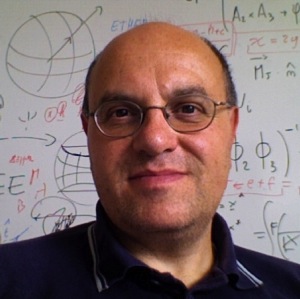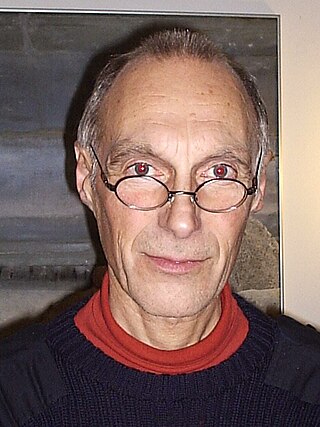Related Research Articles

In physics, physical chemistry and engineering, fluid dynamics is a subdiscipline of fluid mechanics that describes the flow of fluids—liquids and gases. It has several subdisciplines, including aerodynamics and hydrodynamics. Fluid dynamics has a wide range of applications, including calculating forces and moments on aircraft, determining the mass flow rate of petroleum through pipelines, predicting weather patterns, understanding nebulae in interstellar space and modelling fission weapon detonation.
In physics, statistical mechanics is a mathematical framework that applies statistical methods and probability theory to large assemblies of microscopic entities. Sometimes called statistical physics or statistical thermodynamics, its applications include many problems in the fields of physics, biology, chemistry, neuroscience, computer science, information theory and sociology. Its main purpose is to clarify the properties of matter in aggregate, in terms of physical laws governing atomic motion.

In physics, mathematics, engineering, and related fields, a wave is a propagating dynamic disturbance of one or more quantities. Periodic waves oscillate repeatedly about an equilibrium (resting) value at some frequency. When the entire waveform moves in one direction, it is said to be a travelling wave; by contrast, a pair of superimposed periodic waves traveling in opposite directions makes a standing wave. In a standing wave, the amplitude of vibration has nulls at some positions where the wave amplitude appears smaller or even zero. Waves are often described by a wave equation or a one-way wave equation for single wave propagation in a defined direction.
The de Broglie–Bohm theory, also known as the pilot wave theory, Bohmian mechanics, Bohm's interpretation, and the causal interpretation, is an interpretation of quantum mechanics. It postulates that in addition to the wavefunction, an actual configuration of particles exists, even when unobserved. The evolution over time of the configuration of all particles is defined by a guiding equation. The evolution of the wave function over time is given by the Schrödinger equation. The theory is named after Louis de Broglie (1892–1987) and David Bohm (1917–1992).

Mathematical physics refers to the development of mathematical methods for application to problems in physics. The Journal of Mathematical Physics defines the field as "the application of mathematics to problems in physics and the development of mathematical methods suitable for such applications and for the formulation of physical theories". An alternative definition would also include those mathematics that are inspired by physics, known as physical mathematics.
The stationary-action principle – also known as the principle of least action – is a variational principle that, when applied to the action of a mechanical system, yields the equations of motion for that system. The principle states that the trajectories are stationary points of the system's action functional.
The many-body problem is a general name for a vast category of physical problems pertaining to the properties of microscopic systems made of many interacting particles. Microscopic here implies that quantum mechanics has to be used to provide an accurate description of the system. Many can be anywhere from three to infinity, although three- and four-body systems can be treated by specific means and are thus sometimes separately classified as few-body systems.
In condensed matter physics, a quasiparticle is a concept used to describe a collective behavior of a group of particles that can be treated as if they were a single particle. Formally, quasiparticles and collective excitations are closely related phenomena that arise when a microscopically complicated system such as a solid behaves as if it contained different weakly interacting particles in vacuum.
In theoretical physics and applied mathematics, a field equation is a partial differential equation which determines the dynamics of a physical field, specifically the time evolution and spatial distribution of the field. The solutions to the equation are mathematical functions which correspond directly to the field, as functions of time and space. Since the field equation is a partial differential equation, there are families of solutions which represent a variety of physical possibilities. Usually, there is not just a single equation, but a set of coupled equations which must be solved simultaneously. Field equations are not ordinary differential equations since a field depends on space and time, which requires at least two variables.
Fluid mechanics is the branch of physics concerned with the mechanics of fluids and the forces on them. It has applications in a wide range of disciplines, including mechanical, aerospace, civil, chemical, and biomedical engineering, as well as geophysics, oceanography, meteorology, astrophysics, and biology.

David Pierre Ruelle is a Belgian and naturalized French mathematical physicist. He has worked on statistical physics and dynamical systems. With Floris Takens, Ruelle coined the term strange attractor, and developed a new theory of turbulence.
The quantum potential or quantum potentiality is a central concept of the de Broglie–Bohm formulation of quantum mechanics, introduced by David Bohm in 1952.
In theoretical physics, the Madelung equations, or the equations of quantum hydrodynamics, are Erwin Madelung's equivalent alternative formulation of the Schrödinger equation, written in terms of hydrodynamical variables, similar to the Navier–Stokes equations of fluid dynamics. The derivation of the Madelung equations is similar to the de Broglie–Bohm formulation, which represents the Schrödinger equation as a quantum Hamilton–Jacobi equation.

Classical mechanics is a physical theory describing the motion of objects such as projectiles, parts of machinery, spacecraft, planets, stars, and galaxies. The development of classical mechanics involved substantial change in the methods and philosophy of physics. The qualifier classical distinguishes this type of mechanics from physics developed after the revolutions in physics of the early 20th century, all of which revealed limitations in classical mechanics.

In fluid dynamics, hydrodynamic stability is the field which analyses the stability and the onset of instability of fluid flows. The study of hydrodynamic stability aims to find out if a given flow is stable or unstable, and if so, how these instabilities will cause the development of turbulence. The foundations of hydrodynamic stability, both theoretical and experimental, were laid most notably by Helmholtz, Kelvin, Rayleigh and Reynolds during the nineteenth century. These foundations have given many useful tools to study hydrodynamic stability. These include Reynolds number, the Euler equations, and the Navier–Stokes equations. When studying flow stability it is useful to understand more simplistic systems, e.g. incompressible and inviscid fluids which can then be developed further onto more complex flows. Since the 1980s, more computational methods are being used to model and analyse the more complex flows.

Renzo Luigi Ricca is an Italian-born applied mathematician, professor of mathematical physics at the University of Milano-Bicocca. His principal research interests are in classical field theory, dynamical systems and structural complexity. He is known for his contributions to the field of geometric and topological fluid dynamics and, in particular, for his work on geometric and topological aspects of kinetic and magnetic helicity, and physical knot theory in general.
Geometric mechanics is a branch of mathematics applying particular geometric methods to many areas of mechanics, from mechanics of particles and rigid bodies to fluid mechanics and control theory.

Igor Dmitrievich Chueshov was a Ukrainian mathematician. He was both a correspondent member of the Mathematics section of the National Academy of Sciences of Ukraine and a professor in the Department of Mathematical Physics and Computational Mathematics at the National University of Kharkiv.

Hans J. van Ommeren Dekker is a Dutch theoretical physicist in the line of Dirk Polder, Ralph Kronig, and Nico van Kampen. His scientific work inter alia involves laser theory, path integrals in curved spaces, nonequilibrium statistical mechanics, dissipation in quantum mechanics, and hydrodynamic turbulence. He is director of the Private Institute for Advanced Study and professor emeritus at the Institute for Theoretical Physics of the University of Amsterdam.
Yves Pomeau, born in 1942, is a French mathematician and physicist, emeritus research director at the CNRS and corresponding member of the French Academy of sciences. He was one of the founders of the Laboratoire de Physique Statistique, École Normale Supérieure, Paris. He is the son of literature professor René Pomeau.
References
- ↑ Shabbir A. Khan; Michael Bonitz (2014). "Quantum Hydrodynamics". In Michael Bonitz; Jose Lopez; Kurt Becker; Hauke Thomsen (eds.). Complex Plasmas. Springer Series on Atomic, Optical, and Plasma Physics. Vol. 82. Springer. pp. 103–152. Bibcode:2014cpsc.book.....B. doi:10.1007/978-3-319-05437-7. ISBN 978-3-319-05436-0. ISSN 1615-5653.
- Robert E. Wyatt (2005). Quantum Dynamics with Trajectories: Introduction to Quantum Hydrodynamics. Springer. ISBN 978-0-387-22964-5.